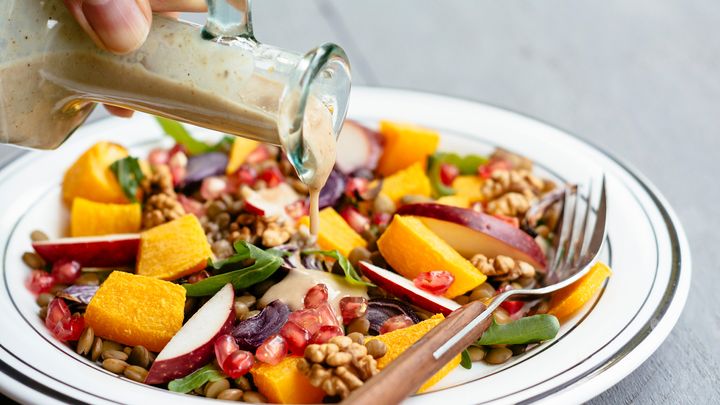If you’re trying to lose weight, a salad dressing is an important consideration. But which one is best?
Look for low-fat and fat-free options. However, make sure they don’t contain a lot of sugar, high-fructose corn syrup or preservatives. Also watch for sodium, which can add up quickly. Kelsey Lorencz, RD, suggests less than 5 percent of the Daily Value per serving.
1. Flavor
Store-bought salad dressings can contain hidden sugars and lots of sodium, so it’s important to read labels carefully. If a salad dressing has a long list of ingredients or high levels of sugar, preservatives and sodium, opt for a different choice.
Look for salad dressings that use natural honey and Creole mustard to add flavor without added sugar. You’ll also find Bolthouse Farms low calorie yogurt dressings which are creamy with less fat than traditional dressings and have no artificial colors or preservatives.
Choose a salad dressing with healthy unsaturated fats like olive oil and avocado oil, or make your own oil-and-vinegar dressing. You can add a splash of fresh lemon juice or lime juice for an extra zesty flavor, or spice up your dressing with ground pepper and herbs.
Adding healthy fats like olive oil and avocado oil helps the body absorb vitamins A, D and E. It can also help the body to metabolize fiber and protein. But be careful, as healthy fats do contain calories, so eat them in small amounts.
Look for a salad dressing that contains omega-3 fats, which are found in fish, or try an egg-free version made with mayo and eggs instead of cream. You can also add a sprinkle of chia seeds, flax seeds or psyllium husk to the dressing to boost your intake of these healthy fats.
2. No Artificial Preservatives or Coloring
Ideally, salad dressings should be low in calories and fat and contain healthy, unsaturated fats. If you’re on the hunt for a heart-healthy creamy dressing, opt for one made with olive, nut or avocado oil instead of buttermilk or mayonnaise, which are high in saturated fats. Keep in mind that some dressings are also high in sugar and sodium, so read the label to find a good option.
A vinaigrette made with vinegar, honey, mustard, lemon juice, and olive oil is a great option for those looking to cut back on calories. It also contains heart-healthy fats and antioxidants. This sweet, strawberry-flavored dressing is another good choice. It doesn’t have any added sugar and is also low in sodium. It’s also free of sucralose, which recent studies have linked to gut dysbiosis and tumor growth.
Another good option is a creamy dressing made with yogurt, olive, canola, or avocado oil. Be careful when choosing this kind of dressing, though, as many of them are high in saturated fats and can have a relatively high sodium content per serving. Look for one that is free of high-fructose corn syrup (HFCS), as well as artificial preservatives and stabilizers like EDTA, sodium benzoate, or potassium sorbate, which have been linked to adverse health effects.
3. Low Sodium
A salad dressing that contains a lot of sodium can add too many calories to your meal and slow down weight loss. A good salad dressing should have no more than 100 milligrams of sodium per serving, which is about two tablespoons.
Look for a low-sodium salad dressing that also doesn’t contain any sugar. Too much sugar can lead to a higher calorie count and potentially cause blood sugar spikes. You should try to stick with a salad dressing that has 3-5 grams of sugar or less per serving.
If you prefer a creamy salad dressing, try to find one that is made with heart-healthy fats such as olive or avocado oil rather than milk or anchovy. These healthy fats help to keep you full and satiated longer than other types of fats.
The best salad dressing for weight loss should have a lot of healthy fats and no salt, sugar or unhealthy vegetable oils like canola or cottonseed oil. It should be made with a blend of herbs and spices instead of processed ingredients that you can’t even pronounce. It should also have the right amount of natural fatty acids that can help your body absorb other essential nutrients, such as calcium and magnesium. The best salad dressing for weight loss should also have a blend of soluble fiber to help you feel fuller after eating your meal.
4. Healthy Fats
A salad is a great way to get in a variety of healthy veggies, but be careful not to overdo it with high-calorie toppings like cheese and tortilla strips. In addition to being full of saturated fat and sodium, these items can quickly add up to more calories than the entire salad.
Look for dressings that contain heart-healthy olive, canola, or avocado oils. These healthy fats can help your body absorb and retain nutrients, and they will also boost the flavor of your meal.
Another ingredient to keep an eye out for is sugar. Many salad dressings are sweetened with high-fructose corn syrup or table sugar, which can easily tack on extra calories to your meal. Check for a low-sugar or no-sugar label when shopping.
A final ingredient to consider is how much vitamin A, C, and E the salad dressing contains. Vitamin A, C, and E are antioxidants that can support weight loss, immune function, and a strong metabolism.
While the calorie count is a little high on this option, it gets high marks for the amount of vitamin A, C, and E as well as the use of heart-healthy oils. Plus, it is a good choice for those who want to find a creamy salad dressing. Just be sure to watch the portion size, as two tablespoons can contain more than 100 calories.

